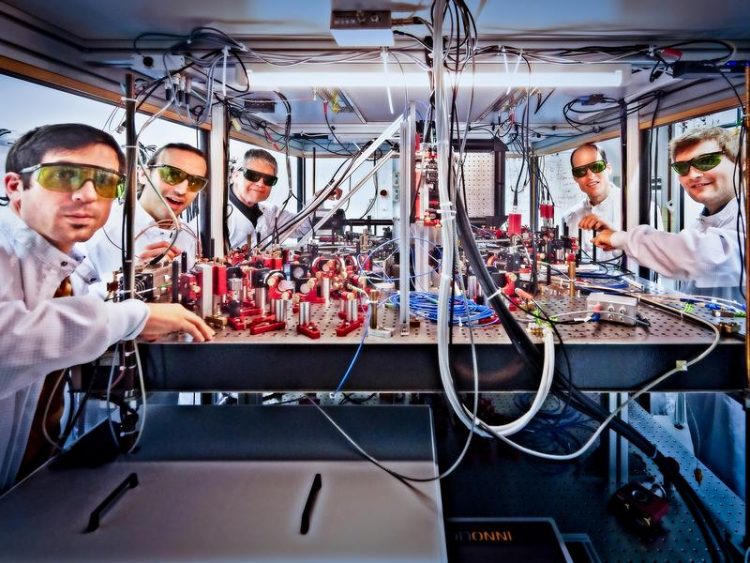Sorting machine for atoms

The physicists from University of Bonn (from left): Dr. Andrea Alberti, Carsten Robens, Prof. Dr. Dieter Meschede, Dr. Wolfgang Alt and Stefan Brakhane. © Foto: Volker Lannert/Uni Bonn
Imagine you are standing in a grocery store buying apple juice. Unfortunately, all of the crates are half empty because other customers have removed individual bottles at random. So you carefully fill your crate bottle by bottle.
But wait: The neighboring crate is filled in exactly the opposite way! It has bottles where your crate has gaps. If you could lift these bottles in one hit and place them in your crate, it would be full straight away. You could save yourself a lot of work.
Unfortunately, such solutions don’t (yet) exist for half-empty drinks crates. However, physicists at the University of Bonn want to sort thousands of atoms however they like in the future in this way – and in a matter of seconds. Around the world, scientists are currently looking for methods that enable sorting processes in the microcosm.
The proposal by Bonn-based researchers could push the development of future quantum computers a crucial step forward. This allows atoms to interact with each other in a targeted manner in order to be able to exploit quantum-mechanical effects for calculations. In addition, the particles have to be brought into spatial proximity with one another.
Magnetized atoms on optical conveyor belts
The physicists are using a special property of atoms to create their sorting machine: These rotate around their own axis like little spinning tops. The direction of rotation – the spin – can be influenced with microwaves. The physicists thus initially set all of the atoms off in the same direction of rotation in their experiment.
In this state, it was possible to load the particles onto a laser beam. However, beforehand, they had to manipulate the laser in such a way that it matched the spin of its particles – a process known as polarization. The atoms were then held by the polarized laser beam in such a manner that they were unable to move. Every particle occupies a particular place on the laser beam – similar to the bottles in the crate.
However, like in the drinks crate, some of the places in the laser beam are also unoccupied. “We thus reversed the direction of rotation in a very targeted manner for individual atoms,” explains Dr. Andrea Alberti, the team leader at the Institute of Applied Physics of the University of Bonn. “These particles were then no longer captured by our laser beam. However, we were able to grab them with a second, differently polarized laser beam and thus move them as desired.
The transport beam can, in principle, move as many atoms as one likes at the same time. As this takes place, they retain their position to each other. As in the example with the bottles, several particles can thus be lifted at once and placed in the gaps between other atoms in one go. “Our sorting method is thus extremely efficient,” explains the lead author of the study, Carsten Robens. “It does not make any major difference whether we are sorting hundreds or thousands of atoms – the time needed only increases slightly.” For the moment, the researchers only worked with four atoms in their experiment, which is now being published.
In principle, the method is suitable for creating any atom pattern. This makes it interesting for solid-state physicists, for instance, to investigate the behavior of semiconductor crystals under certain conditions.
Publication: Carsten Robens, Jonathan Zopes, Wolfgang Alt, Stefan Brakhane, Dieter Meschede, and Andrea Alberti: Low-entropy states of neutral atoms in polarization-synthesized optical lattices; Physical Review Letters
Contact:
Carsten Robens
Institute of Applied Physics (IAP)
University of Bonn
Tel. +49 (0)228/73-3484
E-mail: Robens@iap.uni-bonn.de
Dr. Andrea Alberti
Institute of Applied Physics (IAP)
University of Bonn
Tel. +49 (0)228/733471
E-mail: alberti@iap.uni-bonn.de
www: http://quantum-technologies.iap.uni-bonn.de
https://doi.org/10.1103/PhysRevLett.118.065302 Publication
Media Contact
All latest news from the category: Physics and Astronomy
This area deals with the fundamental laws and building blocks of nature and how they interact, the properties and the behavior of matter, and research into space and time and their structures.
innovations-report provides in-depth reports and articles on subjects such as astrophysics, laser technologies, nuclear, quantum, particle and solid-state physics, nanotechnologies, planetary research and findings (Mars, Venus) and developments related to the Hubble Telescope.
Newest articles

Pinpointing hydrogen isotopes in titanium hydride nanofilms
Although it is the smallest and lightest atom, hydrogen can have a big impact by infiltrating other materials and affecting their properties, such as superconductivity and metal-insulator-transitions. Now, researchers from…

A new way of entangling light and sound
For a wide variety of emerging quantum technologies, such as secure quantum communications and quantum computing, quantum entanglement is a prerequisite. Scientists at the Max-Planck-Institute for the Science of Light…

Telescope for NASA’s Roman Mission complete, delivered to Goddard
NASA’s Nancy Grace Roman Space Telescope is one giant step closer to unlocking the mysteries of the universe. The mission has now received its final major delivery: the Optical Telescope…



